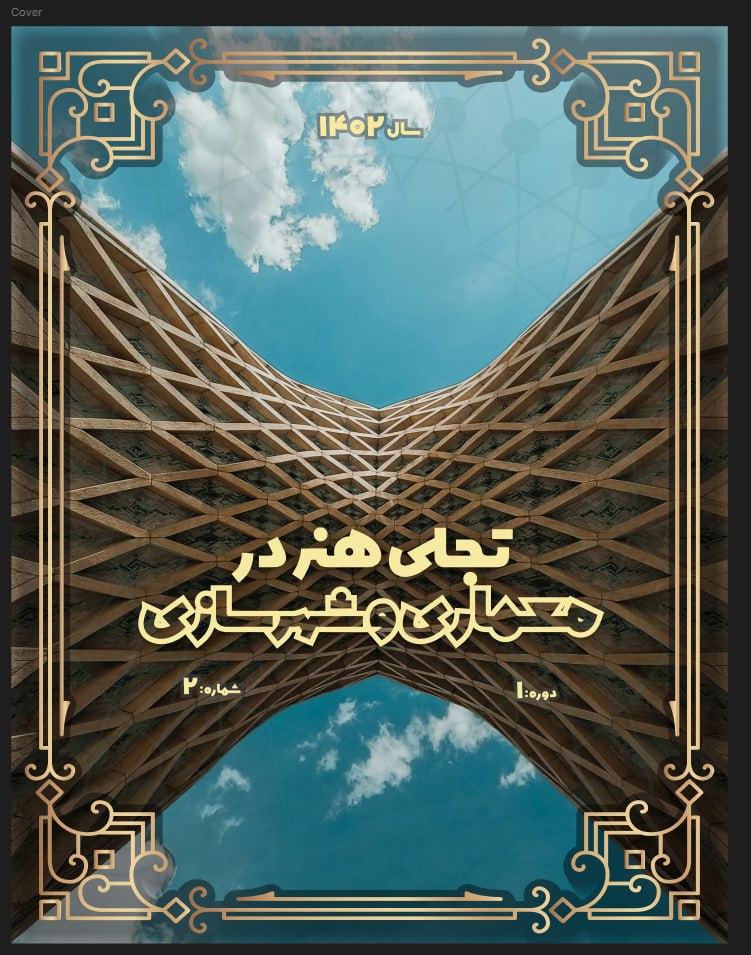ارائه مدل مفهومی ساختمانهای پایدار در مناطق گرم و مرطوب: تحلیل مصرف انرژی با استفاده از شبیهسازی و شبکه عصبی مصنوعی (مطالعه موردی: هرمزگان)
کلمات کلیدی:
ساختمانهای پایدار, شبکه عصبی مصنوعی, پیشبینی مصرف انرژی, مناطق گرم و مرطوب, شبیهسازی انرژیچکیده
هدف پژوهش، ارائه یک مدل مفهومی برای طراحی ساختمانهای پایدار در مناطق گرم و مرطوب با بهرهگیری از شبیهسازی و شبکه عصبی مصنوعی بهمنظور پیشبینی و بهینهسازی مصرف انرژی است. این پژوهش از نوع کاربردی و با رویکرد کمی-تحلیلی انجام شد. در فاز طراحی، متغیرهایی همچون نوع مصالح، ضخامت دیوار و سقف، نوع سیستم تهویه، گرایش ساختمان، و رفتار ساکنان بهعنوان متغیرهای مستقل و مصرف انرژی، دمای داخلی، و رطوبت بهعنوان متغیرهای وابسته در نظر گرفته شدند. دادهها از طریق شبیهسازی با نرمافزار EnergyPlus و تحلیل شبکه عصبی مصنوعی (ANN) جمعآوری و پردازش شدند. شبکه عصبی با استفاده از الگوریتم MLPRegressor با دو لایه پنهان (هر یک شامل ده نورون)، نرخ یادگیری 0.001 و مکانیزم توقف زودهنگام آموزش داده شد. دادهها به نسبت 70 به 30 میان آموزش و آزمون تقسیم شدند و دقت مدل با شاخص خطای میانگین مربعات (MSE) ارزیابی گردید. نتایج نشان داد که شبکه عصبی مصنوعی توانایی بالایی در پیشبینی مصرف انرژی در ساختمانهای مناطق گرم و مرطوب دارد. مقایسه میان مصرف واقعی و پیشبینیشده نشان داد که تفاوتهایی در برخی ساختمانها وجود دارد که ناشی از تغییرات اقلیمی یا رفتار ساکنین است. تحلیل MSE نشان داد که ضخامت دیوار (94356.66)، ضخامت سقف (90021.62)، دمای داخلی (86698.37) و رطوبت داخلی (92751.18) بیشترین تأثیر را بر مصرف انرژی دارند. همچنین، سقفهای چوبی و دیوارهای آجری با ضریب انتقال حرارتی پایین موجب کاهش مصرف انرژی شدند. مدل مفهومی پیشنهادی بر بهکارگیری مصالح با ویژگیهای حرارتی مناسب، کنترل دمای داخلی و رطوبت از طریق سیستمهای هوشمند و طراحی اقلیمپایدار تأکید دارد. نتایج پژوهش نشان داد که ادغام شبیهسازی و شبکه عصبی مصنوعی میتواند ابزار مؤثری برای پیشبینی و بهینهسازی مصرف انرژی در ساختمانهای مناطق گرم و مرطوب باشد. این رویکرد با شناسایی متغیرهای مؤثر بر مصرف انرژی و ارائه مدل مفهومی طراحی پایدار، به طراحان و مهندسان کمک میکند تا با انتخاب ترکیب مناسب مصالح و کنترل شرایط محیطی، مصرف انرژی را کاهش داده و آسایش حرارتی و زیستمحیطی را ارتقا دهند.
دانلودها
مراجع
1. Hafez FS, Sa'di B, Gamal S, Taufiq-Yap Y, Alrifaey M, Seyedmahmoudian M, et al. Energy Efficiency in Sustainable Buildings: A Systematic Review with Taxonomy, Challenges, Motivations, Methodological Aspects, Recommendations, and Pathways for Future Research. Energy Strategy Reviews. 2023;45:101013.
2. Khalil M, McGough A, Pourmirza Z, Pazhoohesh M, Walker S. Machine Learning, Deep Learning and Statistical Analysis for forecasting building energy consumption - A systematic review. Eng Appl Artif Intell. 2022;115:105287.
3. Elbeltagi E, Wefki H, Khallaf R. Sustainable Building Optimization Model for Early-Stage Design. Buildings. 2023;13(1):74.
4. Runge J, Zmeureanu R. Forecasting Energy Use in Buildings Using Artificial Neural Networks: A Review. Energies. 2019.
5. Mohandes SR, Zhang X, Mahdiyar A. A comprehensive review on the application of artificial neural networks in building energy analysis. Neurocomputing. 2019;340:55-75.
6. Wunsch A, Liesch T, Broda S. Groundwater level forecasting with artificial neural networks: a comparison of long short-term memory (LSTM), convolutional neural networks (CNNs), and non-linear autoregressive networks with exogenous input (NARX). Hydrology and Earth System Sciences. 2021;25:1671-87.
7. Wei Y, Xia L, Pan S, Wu J, Zhang X, Han M, et al. Prediction of occupancy level and energy consumption in office building using blind system identification and neural networks. Applied Energy. 2019.
8. Tamimi S, Farhang. Management of Construction and Creation of an Intelligent Energy Production System for Buildings Utilizing Available Renewable Resources. Pars Project Management. 2025;1(1):124-50.
9. Murathan EK, Manioğlu G. Impact of urban form on energy performance, outdoor thermal comfort, and urban heat Island: A case study in Istanbul. Energy and Buildings. 2025:116109.
10. Karimi S, Liobikienė G, Alitavakoli F. The Effect of Religiosity on Pro-environmental Behavior Based on the Theory of Planned Behavior: A Cross-Sectional Study among Iranian Rural Female Facilitators. Front Psychol. 2022;13:745019.
11. Mansoor M, Wijaksana TI. Predictors of pro-environmental behavior: Moderating role of knowledge sharing and mediatory role of perceived environmental responsibility. J Environ Plan Manag. 2022;66:1-19.
12. Zeng Z, Zhong W, Naz S. Can Environmental Knowledge and Risk Perception Make a Difference? The Role of Environmental Concern and Pro-Environmental Behavior in Fostering Sustainable Consumption Behavior. Sustainability. 2023;15:4791.
13. Díaz MF, Charry A, Sellitti S, Ruzzante M, Enciso K, Burkart S. Psychological Factors Influencing Pro-environmental Behavior in Developing Countries: Evidence From Colombian and Nicaraguan Students. Front Psychol. 2020;11:580730.
14. Saari UA, Damberg S, Frömbling L, Ringle CM. Sustainable consumption behavior of Europeans: The influence of environmental knowledge and risk perception on environmental concern and behavioral intention. Ecol Econ. 2021;189:107155.
15. Yusliza M, Amirudin A, Rahadi R, Athirah NNS, Ramayah T, Muhammad Z, et al. An Investigation of Pro-Environmental Behaviour and Sustainable Development in Malaysia. Sustainability. 2020;12:7083.
16. Ruiz-Mallén I, Heras M. What Sustainability? Higher Education Institutions' Pathways to Reach the Agenda 2030 Goals. Sustainability. 2020;12:1290.
17. Weiss M, Barth M, Wiek A, von Wehrden H. Drivers and Barriers of Implementing Sustainability Curricula in Higher Education-Assumptions and Evidence. High Educ Stud. 2021;11:42-64.
18. Kohl K, Hopkins C, Barth M, Michelsen G, Dlouhá J, Razak DA, et al. A whole-institution approach towards sustainability: A crucial aspect of higher education's individual and collective engagement with the SDGs and beyond. Int J Sustain High Educ. 2021;23:218-36.
19. Longoria LC, López-Forniés I, Sáenz DC, Sierra-Pérez J. Promoting sustainable consumption in Higher Education Institutions through integrative co-creative processes involving relevant stakeholders. Sustain Prod Consum. 2021;28:445-58.
20. Mayhoub MMG, El Sayad ZMT, Ali AAM, Ibrahim MG. Assessment of Green Building Materials' Attributes to Achieve Sustainable Building Façades Using AHP. Buildings. 2021;11(10):474.
21. Baqer NR, Rashidi-Khazaee P. Residential Building Energy Usage Prediction Using Bayesian-Based Optimized XGBoost Algorithm. IEEE Access. 2025.
22. Sharston R, Singh M. Urban morphology, urban heat island (UHI) and building energy consumption: A critical review of methods and relationships among influential parameters. Building Services Engineering Research & Technology. 2025:01436244251339727.
23. Gholami H, Kamelnia H, Mahdavinejad MJ, Sangin H. Optimizing Building Configuration and Orientation for Social Housing Projects in Iran. Iranica Journal of Energy & Environment. 2025;16(2):289-308.
24. Yafi E, Tehseen S, Haider S. Impact of Green Training on Environmental Performance through Mediating Role of Competencies and Motivation. Sustainability. 2021;13:5624.
25. Wang J, Yang M, Maresova P. Sustainable Development at Higher Education in China: A Comparative Study of Students' Perception in Public and Private Universities. Sustainability. 2020;12:2158.
26. Nahar N, Hossain Z, Mahiuddin S. Assessment of the environmental perceptions, attitudes, and awareness of city dwellers regarding sustainable urban environmental management: a case study of Dhaka, Bangladesh. Environ Dev Sustain. 2022.
27. Quoquab F, Mohammad J, Sukari NN. A multiple-item scale for measuring "sustainable consumption behaviour" construct: Development and psychometric evaluation. Asia Pac J Mark Logist. 2019;31:791-816.
28. Jafri A, Villenuve E, Agelin-Chaab M, Hangan H. Experimental investigation of building mock-ups and air source heat pumps in cold climates. Energy and Built Environment. 2025.
29. Escamilla-García A, Soto-Zarazúa GM, Toledano-Ayala M, Rivas-Araiza E, Gastélum-Barrios A. Applications of Artificial Neural Networks in Greenhouse Technology and Overview for Smart Agriculture Development. Applied Sciences. 2020.
دانلود
چاپ شده
ارسال
بازنگری
پذیرش
شماره
نوع مقاله
مجوز
حق نشر 2025 Seyedshahab Sadri (Author); Mohammad Behzadpour; Cyrus Bavar, Hossein Aali (Author)

این پروژه تحت مجوز بین المللی Creative Commons Attribution-NonCommercial 4.0 می باشد.









